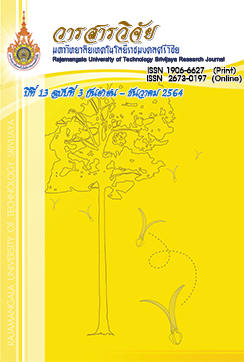The Potential of Biosurfactant from Pomelo Peel Fermentation for Bacterial Inhibition
Keywords:
biosurfactant, pomelo peel waste, bacterial inhibitionAbstract
The objective of this research was to investigate the production and properties of biosurfactant from fermented pomelo peel waste with water in 4 ratio 1:1, 2:1, 3:1, and 4:1 respectively for 3 months. The result showed that the emulsion ability (EA) of pomelo peel waste with water in the ratio of 1: 1 had the highest emulsion value up to 51.64 percent. Therefore, the ratio 1: 1 was chosen to compare the methods of biosurfactant harvesting with various extraction methods. It was found that the extraction of biological surfactants with chloroform: methanol (2: 1) and the crude extraction of biosurfactant at 0.45 grams per liter. Biosurfactant has the ability to reduce surfactants in the pH range 4-10 of temperature between 25-121 degrees Celsius and sodium chloride salt concentration range from 0-12 percent by weight. The concentration range of magnesium chloride was 0-0.1 percent by weight and that of calcium chloride was 0-0.4 percent by weight. For the bacterial inhibition, the MIC (Minimal Inhibitory Concentration) of E. coli Salmonella sp. S. aureus and B. cereus was 25 25 6.25 and 1.56 milligrams per milliliter, respectively and the MBC (Minimal Bactericidal Concentration) value was 50 milligrams per milliliter.
References
Abouseoud, M., Maachi, R., Amrane, A., Boudergua, S. and Nabi, A. 2008. Evaluation of different carbon and nitrogen sources in production of biosurfactant by Pseudomonas fluorescens. Desalination 223: 143-151.
Arun, K.P., Nilotpala, P. Lala, B.S. Prasanna, K.P. and Barda, K.M. 2014. Inhibition of pathogenic bacterial biofilm by biosurfactant produced by Lysinibacillus fusiformis S9. Bioprocess Biosystem Enginerring 37: 139-149.
Dikit, P., Maneerat, C. and Saimmai, A. 2019. The effective emulsifying property of biosurfactant-producing Marinobacter hydrocarbonoclasticus ST1 obtained from palm oil contaminated sites. Applied Biochemistry and Microbiology 55(6): 615-625.
Gasaluck, P. and Unsirilai, R. 2010. Research Report no Biosurfactant from sour cherry (Prunus cerasus L.) conventional fermentation. final. Suranaree University, Thailand. (in Thai)
Maneerat, S. and Phetrong, K. 2007. Isolation of biosurfactant-producing marine bacteria and characteristics of selected biosurfactant. Songklanakarin Journal of Science and Technology 29(3): 781-791.
Saimmai, A., Sobhon, V. and Maneerat, S. 2012. Production of biosurfactant from a new and promising strain of Leucobacter komagatae 183. Annal of Microbiology 62: 391-402.
Thimon, L., Peypoux, F. and Michel, G. 1992. Interactions of surfactin, a biosurfactant from Bacillus subtilis with inorganic cations. Bioresource technology Letter 14: 713-718.
Vaz, D.A., Gudinab, E.J., Alameda, E.J., Teixeira, J.A. and Rodrigues, L.R. 2012. Performance of a biosurfactant produced by a Bacillus subtilis strain isolated from crude oil samples as compared to commercial chemical surfactants. Colloids Surfactant 89: 167-174.
Wang, J., Ji, G., Tian, J., Zhang, H., Dong, H. and Yu, L. 2011. Functional characterization of a biosurfactant-producing thermo-tolerant bacteria isolated from an oil reservoir. Petroleum Science 8: 353-356.
Xu, Q., Nakajima, M., Liu, Z. and Shiina, T. 2011. Biosurfactants for microbubble preparation and application. International Journal of Molecular Sciences 12(1): 462-475.
Zhu, Z., Wen, Y. and Yi, J. 2019. Comparison of natural and synthetic surfactants at forming and stabilizing nanoemulsions: Tea saponin, Quillaja saponin, and Tween 80. Journal of Colloid Interface Science 536(15): 80-87.
Downloads
Published
How to Cite
Issue
Section
License
The content and information in the article published in Journal of Rajamangala University of Technology Srivijaya It is the opinion and responsibility of the author of the article. The editorial journals do not need to agree. Or share any responsibility.







